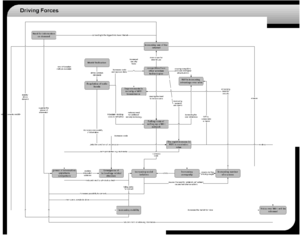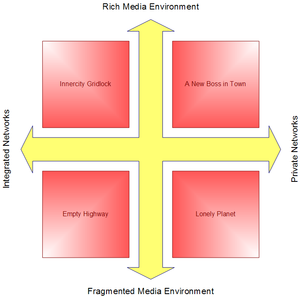The Future of WiFi 2010
GROUP COMPOSITION
- Alok Sharma
- Antje Pfueller
- Michael Davies
- Francisca Mayasari
INTRODUCTION
Wi-Fi or Wireless fidelity is freedom. It allows you to connect to the internet from anywhere without the use of wires. Imagine accessing the internet from the airports, train station, coffee shops and probably while driving. Wi-fi networks use radio technologies like IEEE 802.11a or 802.11b to provide fast and reliable wireless connectivity.Wireless networks can be used to connect computers with each other and also connect them to the internet or other wired devices. Wireless networks operate in the unlicenced free 2.4 Ghz and 5 Ghz radio bands at a speed of 11Mbps for 802.11b standard and 54 Mbps for 802.11a standard. Since Wi-fi is cheaper, faster and easy to set up as a network most organizations are now considering to deploy Wlans as compared to traditional wired LANs. Wi-Fi is also a threat to some industries like the cellular industries who have invested heavily in the 3G technology to provide internet access. Will the cellular companies eventually have to adopt Wi-FI or can they still offer some value with 3G? Perhaps almost every industry will be affected with the Wi-Fi revolution. Hotels will have to deploy Wi-Fi networks to provide better customer satisfaction. Home appliances like Microwave, Cordeless Phones, Vacuum Cleaner etc. could have Wi-Fi enadled chips in the future. Even the TV and music systems, PDAs, mobile phones and perhaps everything would be Wi-Fi enabled. So does this mean that Wi-Fi is the next biggest revolution in IT after the internet or even after the advent of the PC. However since the radio signals travel in the air security could be an issue with the wireless networks. But these problems could be solved with time and if that happens then sky is the limit for Wi-Fi. Some other considerations are the environment and health hazards associated with the use of Wi-Fi. A challenge for the Wi-Fi industry is how to cope up with these and other government regulations that might arise in the future due to the rapid use and availability of Wi-Fi networks.
UNCERTAINTIES
In the following we will approach this topic by taking a look at a series of uncertainties that will affect the development of WiFi in the future. These uncertainties are grouped into 4 areas of influence:
- Technology
- Where are the limits to WiFi Technology?
- Weather conditions, coverage, bandwidth, power transmission, interference with other devices??
- Security Issues?
- New technology developments
- Devices and Security standards
- Where are the limits to WiFi Technology?
- Industry
- Who will be the main beneficiaries?
- Will Wi-Fi seriously effect the cable industry?
- What will be the effect on cellular industry?
- How will the business of Telcos be effetcted with Wi-Fi?
- Will they have to adopt the Wi-Fi Technology or can they survive without it?
- Effect on related industries like PC's, Home appliances,Consumer electronics, Hospitality industry?
- Society
- Will there be any Health Implications?
- Are there any Psychological Implications?
- How will the lifestyle change?
- Work environment?
- Private Life?
- What will be the Impact on different Age groups and how likely will it increase the gap between old and young?
- Do people adopt the new possibilities?
- Government
- Are governments likely to change regulations?
- Will there be any country with specific regulations?
RESEARCH QUESTIONS
Along those lines the following research question developed:
- Technology
- What is WiFi technology?
- Who are the stakeholders in this technology?
- Who has influence over this technology?
- What are the applications of WiFi?
- What devices are currently available?
- What future devices may be available?
- What are the limitations of WiFi?
- What are the technical implications of WiFi?
- What is WiFi technology?
- Industry
- Is Wi-fi complimentary or direct competition to the 3-G services offered by the cellular comapnies?
- Will the use of Voice over Wi-Fi effect the landline business of Telcos? Can WiFi provide last mile connectivity?
- Can Wi-Fi offer the value add which will benefit the service industries like Hotels, Hospitals etc to attract more customers?
- Wimax Vs Wifi? and Intel's role in it?
- Society
- How is the current modern lifestyle? How much technology is involved in forming everyday life?
- Which role does WiFi play today?
- Are there any alternative technologies at hand? How attractive is WiFi compared to those?
- Are there any reported health implications of wireless technology, like f.e. electro smog research done for mobile phones?
- Government
- How is WiFi technology regulated?
ANSWERS TO RESEARCH QUESTIONS
- Technology Related-Answers
- Industry Related-Answers
- Society Related-Answers
- Government Related-Answers
DRIVING FORCES
- The Rapid Increase in WiFi Transmission Rates
- The Improvements in Security of WiFi Transmissions
- Power of Information-anywhere, everywhere
- Cost of Setting up a Wi-Fi Network
- Popularity of Wimax and its features
- Popularity of 4G
- Wireless is better than wire
- Voice over Wi-Fi (Vo-Wi-Fi) will be released
- Alan Greenspan is going to finish his term in Fed
- Increasing social isolation
- Emergence of new Technology Related Diseases
- Other Radio technologies like RFID and Bluetooth
- Skype and its benefits
- Regulation of Hot Spots
- Convergence of standards and interoperability of products
Creating Scenario Plans
The first step to arriving at sceanrios is to analyze the interdependance of driving forces. The following diagram is a summary of the above mentioned driving forces and their interrelation.
To understand the two main dynamics which will direct the scenarios, and to clarify the scenarios' relative position, we next created a Scenario Grid:
SCENARIOS
A New Boss in Town
Lonely Planet
Empty Highway
Innercity Gridlock

